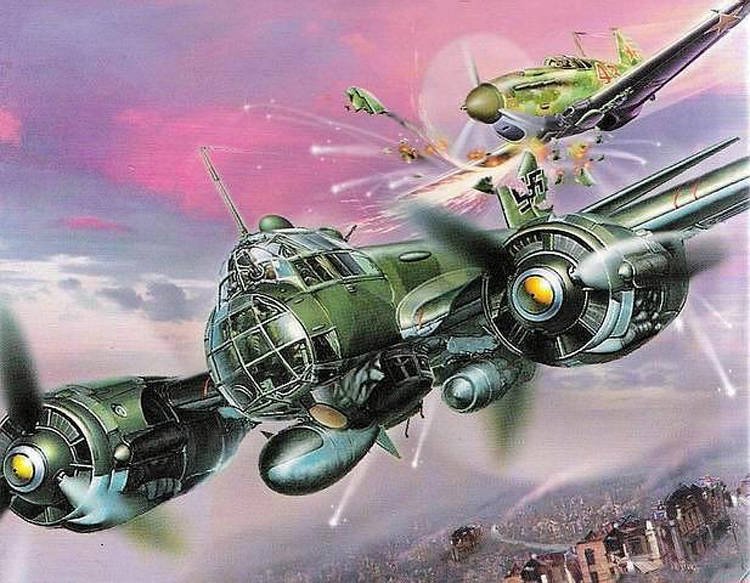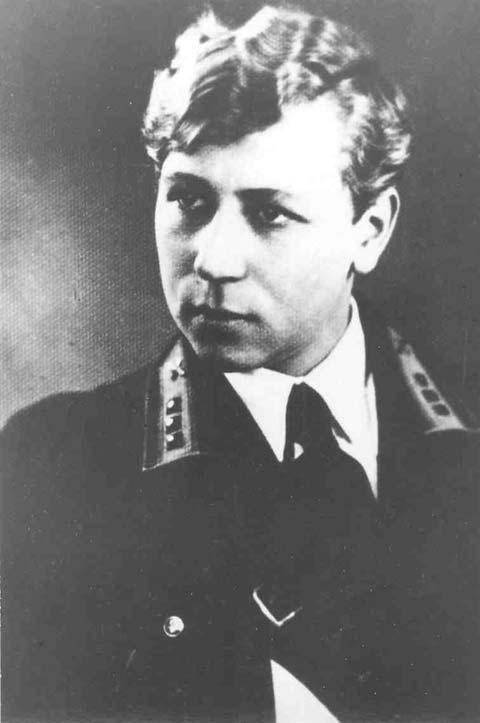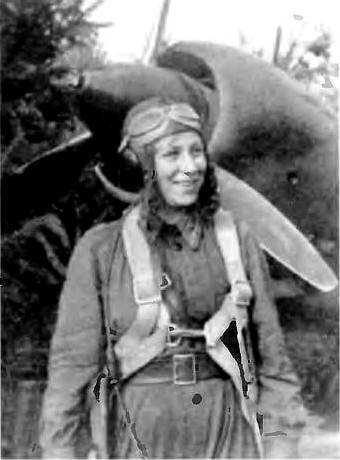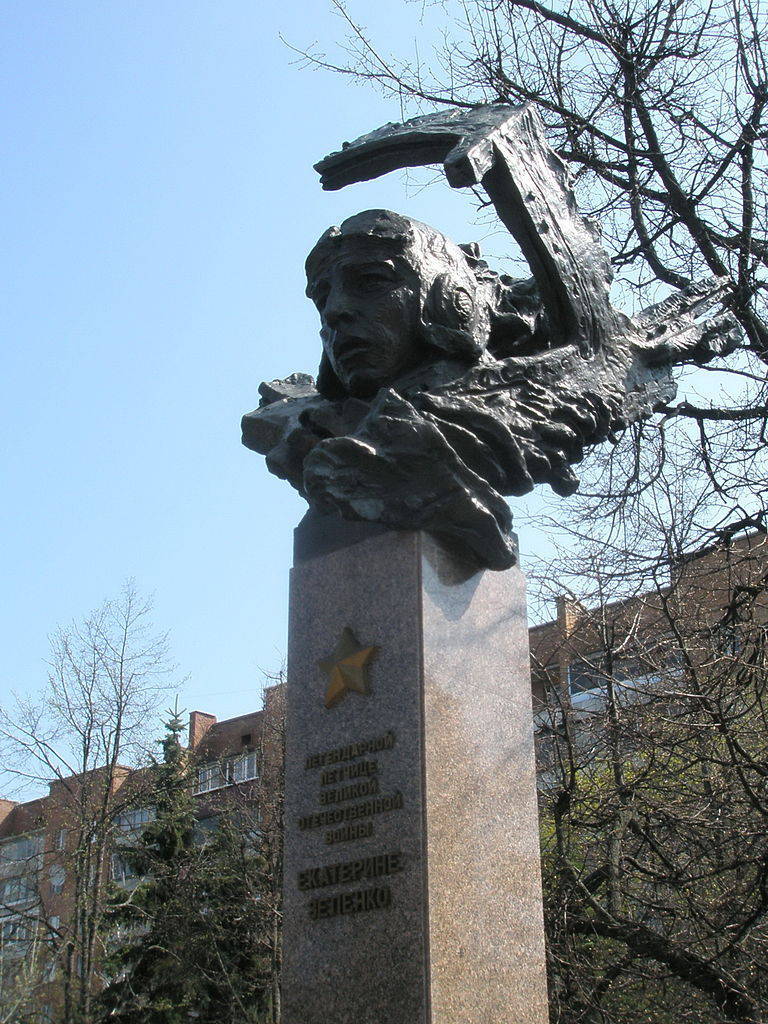Russian Valkyrie

Many unique and at the same time tragic cases of air rams know story Great Patriotic, but one of them is still standing separately - the one that made the woman. Her name was Ekaterina Ivanovna Zelenko.
• ramming with the tail, committed by Bikmukhametov;
• ramming a transport aircraft by a jet fighter piloted by Valentin Kulyapin;
• ramming Serafim Subbotin in the battle over Korea, when he had to release the brake flaps and expose his fighter to the blow of the catching up enemy.
In addition, there are cases of whole “ramfights”, when in the battle between two aircraft, various ram attacks were used consistently.
There are very few documents about Ekaterina Ivanovna’s youth and pre-war service. She was born on one of the 14 versions of September 1916 in the remote village of Koroshchino, located in the Olevsky district of the Zhytomyr region and surrounded by impassable forests and swamps. This place of birth of the future pilot is indicated in the documents lying in the Central Archives of the Ministry of Defense of Russia. Soon there was a revolution in the country, time became turbulent, and her family hurried to move to the big city - Kursk. It was in this city, according to another version, based on the memories of her sister, that Katerina was born. Such confusion is explained simply - the girl was the tenth (!) Child in the family. Her father was from the village of Veliko-Mikhailovskoye in the Kursk region, and her mother, Natalya Vasilyevna Maksimova, from the village of Nazarovka, in the Kostroma region. According to the stories of the pilot's sister, Lyudmila Ivanovna, Katerina grew very energetic and quick, rarely cried and was not at all capricious. I loved to climb trees and fences with the boys, to jump from the roofs of sheds. Katya spent all her childhood in the city of Kursk, here in high school she graduated from the seven-year school.
The desire to become a pilot came into being at Catherine's childhood. Perhaps she was pushed to this by the fact that the two older brothers were studying aviators. When she told them about her dreams, they did not laugh, but they advised to enter the Voronezh Aviation Technical School, which trains workers for the local aircraft factory. In addition, their elder sister, Sophia, had time to settle down in Voronezh. Soon Kati's father passed away, and the girl went to Voronezh with her mother.
In 1932, when she was already in her second year at a technical school, an aeroclub began working in Voronezh. A slogan went around the country: “All Komsomol members are on planes!”, And Katerina Ivanovna was already a member of the Komsomol by that time. This was the only chance to fulfill a long-standing desire. Zelenko recorded in a circle. Among the hundreds of guys there were only a few girls, and Katya had to constantly prove that she could fulfill all kinds of flight standards no worse than men. To do this, she had to show by no means female dexterity, strength and courage, jump with a parachute much more than others, fly on airplanes better than others. And in 1933, a commission arrived at the flying club to search for candidates for military flight schools. Katya Zelenko, along with another girl, Nina Rusakova, managed to pass a rigorous test and was sent for further training in the military aviation Voroshilov School near Orenburg.
At the end of 1934, Ekaterina Ivanovna graduated with honors from the Orenburg School of Pilots and Observer Pilots, in which the most famous aviators and cosmonauts of our country, including Yuri Gagarin, will later learn. So Zelenko was one of the first military test pilots of the Soviet Union. After her studies, she was immediately sent to the nineteenth light bomber air raid, located near Kharkov. Here, while carrying her service, she had to test new aircraft and equipment for them. Over the next four years, the girl happened to fly on seven different types of aircraft.
In the biography of our heroine, there is one case connected with the search for volunteer pilots who wish to participate in a risky experiment in finding the altitude limit when flying without an oxygen device. Hearing this, Ekaterina Zelenko immediately put forward her candidacy. As a justification, she wrote: “A hardy athlete and medalist of the Kharkiv military district in hammer throwing, not tired of overloading.”
Surprisingly, it was accepted and even began to prepare for flight. However, research was soon closed. The bosses realized the meaninglessness of attempts to test people for strength and switched in the direction of creating new airplanes and trouble-free oxygen equipment.
And soon Ekaterina Ivanovna was "lucky" again. Someone did not notice anything strange in the signature of “Lieutenant Zelenko” and signed her request to send the Isthmus to the Karelian Isthmus to the Soviet-Finnish war. So in the winter of 1939-th - 1940-th years the pilot took part in the hostilities for the first time. Around there was a war, and Katya wrote to her sister in Voronezh: “Sonechka, I'm fine! What beautiful places here! Words can not convey. If I were a poet, I would definitely write poems. Forests and forests, without end and without edge, and also lakes and snow, a lot of snow. If it were not for the war ... I have Belofin bandits to carry "Voroshilov kilograms." Lovely hotels, what do you think? And I also became an avid parachutist. As you can see, Sonechka, it’s not for nothing that a bark of a segal with an umbrella! ”
Ekaterina Zelenko flew in the third squadron of the eleventh light bombing regiment of the 8th Army Air Force. By plane Р-Z she made eight sorties. From the documents found, it follows: “Zelenko flies combat missions, is cold-blooded and prudent, guided by difficult conditions and bad weather conditions. The task performs perfectly, is not lost, being shelled with anti-aircraft artillery. The delivered intelligence data is distinguished by accuracy within the scope and duration of the mission, as well as complemented by valuable information obtained with a reasonable initiative. " And soon, for the destruction of the ammunition depot and artillery battery of the Finns, Ekaterina Ivanovna was awarded the Order of the Red Banner. The award was presented in the Kremlin by the Chairman of the All-Russian Central Executive Committee Mikhail Kalinin. During the general photographing, Katerina sat next to him, later, according to the recollections of loved ones, she very much cherished this photo.
During hostilities, the female pilot met the future colonel-general of aviation, Andrey Rykov. As a brigadier commissioner, he visited their airfield deployed on an ice-bound lake. Entering one of the houses where the pilots lived, the discerning political worker was immediately struck by the uncharacteristic purity of the male team. Curtains hung on the windows, a tablecloth on the table. After he asked about who created and maintains such comfort, he was introduced to the "mistress", Senior Lieutenant Ekaterina Zelenko. He recalled how a short-haired girl in a tunic and high fur boots, girdled with an officer's belt, appeared before him. In appearance, she looked like a young guy, and in conversation she noted that she was often confused with a man. Much later, the colonel-general learned that Ekaterina Ivanovna was the only pilot to fight in that campaign.
After the hostilities ended, experienced pilot Ekaterina Zelenko returned to her native nineteenth aviation brigade, belonging to the Kharkov military district. In May, the 1940 of the year she was appointed commander of the aviation, and after a while the new Su-2 bombers came to part. Zelenko immediately asked for the first squadron, the pilots of which were instructed to take planes from the factory and master them. The knowledge gained in the technical school helped her quickly understand the design of the new aircraft. She personally visited the workshops, which collected Soviet bombers, participated in their tests. After Ekaterina successfully “tamed” this car, she took the position of instructor pilot in retraining the commanding staff of a number of aviation regiments of the USSR Air Force (before the war, the aircraft entered the disposal of fourteen air regiments). This work continued from October 1940 of the year to May of 1941 of the year. Catherine was twenty-four years old, and the students who came to her were often much older. However, no one considered it shameful to learn from a young pilot, take Zelenko’s piloting techniques and listen to her instructions. Quite possibly it was because Ekaterina Ivanovna herself flew flawlessly.

In 1940, Ekaterina Zelenko, at the Officers' House in Kharkov, met the young pilot Pavel Ignatenko, the commander of the neighboring squadron. They began to meet in secret: went to the theater, cinema, to concerts. Pavel persuaded her to get married, but Katya did not want a wedding, perhaps she was afraid of publicity. Soon she realized that she was pregnant. According to one of the versions, the authorities did not find her changing figure and didn’t remove her from flying, Catherine began to pull in her stomach, tighten the belt more tightly. Perhaps that is why the young woman had a premature birth. Despite the fact that Katerina herself was healthy, one of the two boys was born dead and the other lived only a few hours. She was terribly worried, and for the rest of her life she wore a locket around her neck with a strand of her son's hair, cut off before the funeral. Also in the medallion lay a photo of her beloved nephew Valentine - the child of Sonia’s sister.
In May 1941, Ignatenko was sent to study at the Zhukovsky Air Force Academy in the capital. “Come on, let’s sign for us before leaving!” He said to the pilot. However, she again refused this time, arguing that in a year she would also go to Moscow. A young couple made a wish to get married in the capital, but war broke out and mixed up all the plans.
At the end of June, Zelenko wrote to Pavel: “Pasha! Today I am going to the front. I know for sure that the war will be a harsh test for me, but I am sure of myself - I will overcome it, I will endure any difficulties. I have never been afraid of them and I will not be afraid of them. Wish me luck. You understand, I will have to postpone entering the academy until we smash all the enemies. Your Katyusha. Upon learning that the beloved is going to war, Ignatenko quit his studies and returned to the regiment to fly with her.
After Catherine Zelenko arrived at the front, she was appointed deputy commander of the fifth squadron of the 135 th light bomber regiment relating to the sixteenth mixed air division. Her first combat departure took place on July 5 1941 year. She flew on a light, single-engine bomber short-range Su-2, which at the beginning of the war was used as an attack aircraft, and as a scout, and as a fighter. The real fighters, whose duties included escorting bombers, were sorely lacking at the front - many of them were destroyed by the Nazis on the first day of the war ... It was impossible to sit and wait until new aircraft came from the rear, so the "bombers" had to fly alone . And, of course, bear huge losses. To save themselves, the pilots lined the planes closer to each other, protecting their comrades with their fire. The regimental craftsmen also did not sit with folded arms, to the five "ShKAS" on the sides of the Su-2 began to add the sixth Degtyarev machine gun, placing it in the very tail. The navigator shot from him from opponents who were trying to get the car behind and below.
In July 1941, the bomber regiment, which served as Catherine, was based near Poltava. One day the pilots received an order to bomb a column of German cars and tanksfollowing the highway. Two links of Su-2 bombers led by senior lieutenant Zelenko were in the air. In the indicated area, they found a target - enemy equipment moving along the road to the east. Hit the anti-aircraft guns.
Maneuvering in the midst of fire and smoke, Soviet aircraft rushed to the target. Bright flashes of explosions bloomed. As a result of the bombing on the highway, a traffic jam formed, cars, tanks and cisterns caught fire. The detachment returned to the airfield without loss, and the photo control testified that more than forty German tanks and two dozen vehicles with infantry and ammunition were damaged. A radiogram came from the front headquarters announcing gratitude to all the pilots who took part in this task.
In August, 1941, the regimental comrades Zelenko persuaded her to play the wedding. After the daily departures in the largest dining-tent, a modest table was set up - vodka and flight rations. In the fields not far from the airfield, the pilots selected several bouquets of flowers to the bride, and the head of supply presented the newlyweds with a brand-new separate tent. And the next morning, all scattered again on their assignments. A few days later, a group of aircraft, headed by Zelenko, caused significant damage to enemy troops in the area of Bykhov.
 The combat experience and skill of a brave pilot grew from flight to flight. Day and night, she successfully carried out all the tasks. For three incomplete months of being on the front line, Ekaterina Ivanovna managed to make about forty sorties. Its main tasks in the air were bombing the clusters of fascist forces and performing reconnaissance operations. Recorded her participation in twelve air battles with German aces. The command was going to present a pilot to a high award.
The combat experience and skill of a brave pilot grew from flight to flight. Day and night, she successfully carried out all the tasks. For three incomplete months of being on the front line, Ekaterina Ivanovna managed to make about forty sorties. Its main tasks in the air were bombing the clusters of fascist forces and performing reconnaissance operations. Recorded her participation in twelve air battles with German aces. The command was going to present a pilot to a high award.In the autumn of 1941, the German command was in a hurry to complete the encirclement of the Kiev group of Soviet troops. On September 12, Colonel Jansen, returning from the reconnaissance flight, commander of the 135 air regiment, said that he had discovered two tank formations that were rapidly moving to the Ukrainian city of Lokhvitsa. “I'm flying. I'll take a look and pobombli ", - suggested the captain Anatoly Pushkin, assistant regiment commander and most experienced pilot, who fought in the skies of China. He returned forty-five minutes later: “He bombed. Tank columns are sent to the compound. We must continue to lead them! Then Yekaterina Zelenko, deputy commander of the fifth air squadron, approached Jansen: “Comrade, will you allow me?”. Despite the fact that Starlez Zelenko was one of the best-trained and experienced regiment pilots, there was one unwritten rule: “Keep Katya and rarely let her go on combat flights.” War, war, but still she was the only woman in the unit. On that day, Zelenko had already made two sorties, and besides the flight over the German positions did not promise low-speed bombers performing the role of aerial reconnaissance aircraft, anything good. And Jansen decided to send the crew of the squadron commander Lebedev to the mission. However, Zelenko did not retreat, demanding to entrust this task to her. The commander surrendered, sending her with Captain Lebedev in a pair.
It is necessary to add that in the regiment after the first and most terrible months of the war, less than half of the aircraft remained in the ranks, many of them were damaged. Yekaterina Ivanovna decided to fly Pushkin's Su-2, already from the cockpit of the plane she shouted: "Here are your leggings and a tablet." “Well, let them stay there,” the captain waved his hand. Anatoly Ivanovich was waiting for the crews to return for about forty to fifty minutes - the standard time for the combat mission on the Su-2. After that, he was distracted by urgent matters - from the headquarters of the twenty-first army they reported that the Germans were approaching the village of Berestovka, near which the regiment was stationed, and immediate redeployment to the city of Lebedin (Sumy region) was necessary. An hour later, Lebedev himself called and reported that he and his co-driver Gavrichev were at a nearby airfield. He said that the mission was flying leading, and Zelenko - driven. Rushing along the Bakhmach – Konotop – Romny route, the air reconnaissance aircraft discovered a cluster of enemy armored vehicles. At the same time, the Messers of the Luftwaffe appeared. German cars were faster, Soviet pilots were divided. Lebedev used the clouds to break away from his pursuers, and managed to get to the airfield. On the fate of the second bomber, he was not aware of anything.
After some time, a part of the exhausted, wounded lieutenant Pavlyk, navigator Katya appeared in the unit. He told the end of the story. The data found by the pilots on the disposition of the enemy troops might be needed by the front command and, so that Lebedev’s plane could get away from the Germans, Katerina decided to divert them by taking the fight. It seems that she understood perfectly well, however, in this case her chances of salvation are meager. According to Nikolai Pavlyk, who was sitting in the back of the cabin and frenziedly shooting back from the German planes that were approaching the "drying" from behind, Kate managed to knock out one "Messerschmitt" from the "ShKAS". After a moment, he ran out of ammunition, it was smelling of fumes, German bullets pounded on the armor rack and one of them hit the lieutenant’s hand. On the verge of fainting, he heard the aircraft commander tell him to jump. He fell out of the car and then lost consciousness. He came to himself only from a jerk of a drop-down parachute and saw the wreckage of the Su-2 and the German Me-109 plane fall to the ground.
The commander of the fourth squadron Pavel Ignatenko was among the first to hear the lieutenant’s story. “You have not seen her dead? Didn't you see it? ”, He refused to believe that his wife was dead. Unfortunately, the Soviet soldiers failed to organize the search for pilots during the retreat that had begun. And soon the territory where she fell was occupied by the enemy. Captain Ignatenko questioned observers from the airfield service units, wrote letters to the hospitals of Moscow, Kharkov and even the Urals, phoned the neighboring airfields and military units. He received disappointing answers: “We didn’t have this.”
There was a time, despite the fierce air battles, frequent redeployment, in the air unit did not forget Catherine. In November 1941, the command presented it to the title of Hero for many successful sorties and for not flinching, fought with seven Nazi aircraft. However, the top decided otherwise, and the pilot was awarded only the Order of Lenin.
In the 1943 year, when the Sumy region was cleared of the fascists, a certain Anastasia Marchenko appeared at the local military registration and enlistment office, bringing a Komsomol ticket spattered in blood. She said that he belonged to a pilot who had rammed a fascist plane over her village Anastasyevka in September of 1941. The wing of the Su-2 hit the Messerschmitt fuselage, breaking it in half. Both cars crashed to the ground, and the Soviet plane fell to the edge of the field, and the German - into the woods. Among the wreckage of the aircraft, local residents found the mutilated body of a pilot in a burnt overalls, thrown out of the cockpit from the impact of an airplane on the ground. Documents - order book, identity card and Komsomol ticket in the name of Ekaterina Ivanovna Zelenko - found in a breast pocket. The girl was wrapped in a preserved parachute and buried in the center of the village, and in the evening the Nazis arrived at Anastasyevka. In a couple of days, Kate would have turned twenty-five years old ...
After the end of the war, thanks to Ukrainian journalists, the story of a brave pilot became publicized. Her remains were transported to Kursk. A small photo of Catherine Ivanovna spread throughout the vast country. The streets in a number of cities, pioneer squads and schools were named after her. An obelisk was erected by the inhabitants of Anastasyevka in honor of Katy's feat. A monument to a brave pilot appeared in the village of Berestovka, located next to the airfield from which she flew off into eternity. It is curious that in honor of Zelenko, Tamara Smirnova, an astronomer at the Crimean Observatory, called the small planet of the Solar System discovered to her. The planet is named "Katyusha". Also in her honor, he named one dry cargo vessel. Katy's Komsomol ticket was transferred to the Orenburg Red Banner Higher Military Aviation School named after Ivan Polbin.

Brother-soldiers also petitioned to confer the rank of Hero of the Soviet Union to the pilot, but the answer came: "The fact of the ram was not confirmed." Only in 1971-th year at the site of the fall of the aircraft earned a government commission. Dozens of witnesses of those events were found and interviewed, parts of the Zelenko aircraft and fragments of the Me-109, on which traces of a ram attack were found, were investigated. And historians, having turned over a lot of documents, established that Catherine was the only woman in the world who committed an air ram. But only many years later, thanks to the efforts of the public, justice triumphed - 5 of May 1990 of the year, according to the decree of the President of the USSR Ekaterina Zelenko, was posthumously awarded the title Hero.
In conclusion, I would like to add that before the start of the ram attack, the Russian pilots had only a general idea. This is understandable, because the history of aviation clearly defined the method as deadly for the performer. It never occurred to anyone to try it out in practice in peacetime. However, the air ramming began from the very first minutes of the war. Already on the first day their number reached fourteen. Fourteen Soviet pilots inscribed their names in the history of the Great War and in the history of aviation. In the following months and years, the number of young guys rushing to the enemy did not decrease. It is unlikely that they thought about destroying the fascist and stay alive. They paid the maximum, giving their lives not for the sake of glory, but only for the sake of the Victory - the one, one for all.
Leaving aside the comparison of Soviet and German aircraft, without even considering the fact that the Soviet command tried to stop the emerging tendency of Soviet aviators to suicide attacks, the majority of young Soviet pilots, who were still unable to fly and conduct air combat, eagerly wanted only one thing - to protect their native land and destroy the enemy. And the most experienced enemy was powerless against such amazing people. Eternal glory to them, eternal memory. All together and individually.
Information sources:
http://www.warheroes.ru/hero/hero.asp?Hero_id=355
http://www.peoples.ru/military/aviation/ekaterina_zelenko/
http://geroykursk.narod.ru/index/0-84
http://airaces.narod.ru/woman/zelenko.htm
Information